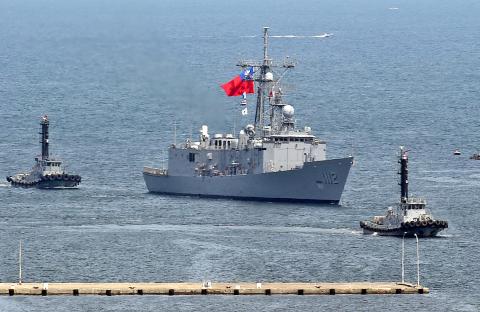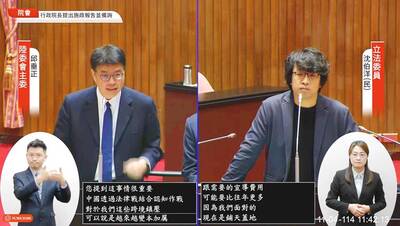The Ministry of National Defense plans to spend more than NT$1.1 billion (US$36 million) to build three special operations and counterterrorism bases over three years for use by the navy and the military police, the ministry’s budget for next year showed.
The navy is to build a multifunctional special operations training base for NT$698.04 million and a maritime special operations training base for NT$134.25 million, while NT$269.21 million has been reserved for a joint special operations training base for the military police, the document said.
The multifunctional base, which is to be equipped with computers that can simulate training scenarios, is slated for use by the Special Service Squadron of the marine corps’ Amphibious Reconnaissance and Patrol Unit, it said.

Photo: Chang Chia-ming, Taipei Times
The program is to have a NT$11.42 million budget next year and base construction should be completed in 2022, it said.
The maritime base is to be used for improving formational and individual combat skills, as well as enhancing amphibious assault and special operations capabilities, it said.
The base is to have facilities for air insertion training and hostage rescue drills on ships, vehicles and airplanes, it said, adding that the base could accommodate the training needs of other military units.
The ministry is to spend NT$4.51 million constructing the maritime base next year and completion is scheduled for 2021, it said.
The joint training base is slated for use by the military police, which has an important role in the defense of Taipei, security operations and urban warfare.
The base is to be capable of simulating conventional military combat, as well as special operations in modern built-up areas, for training of military and regular police units, it said.
The joint training base is to be allotted NT$2.12 million for the portion of the program scheduled for next year and is expected to be completed in 2022, it said.
Separately, the navy next month is to commission two Perry-class guided missile frigates that were bought from the US.
Navy Chief of Staff Vice Admiral Lee Tsung-hsiao (李宗孝) yesterday told the legislature that training and preparations are under way for the commissioning of the two vessels.
When asked how the ships would improve the nation’s defense capability, Lee said that the Perry-class’ anti-submarine capabilities are superior to those of the navy’s eight Cheng Kung-class frigates.
The two frigates, built in the 1980s and named the USS Taylor and USS Gary by the US Navy, were delivered in May last year.
Renamed Ming Chuan (銘傳) and Feng Chia (逢甲), they are to join the navy’s 146th Fleet based in Penghu and would be deployed on patrols in the Taiwan Strait, the navy said.
The vessels are highly mobile and equipped with SQQ-89 undersea warfare combat systems and SQR-19 sonar systems, both of which the navy said would bolster their anti-submarine capabilities.
In December 2014, then-US president Barack Obama authorized the sale of four Perry-class frigates to Taiwan.
The government allocated about NT$5.5 billion for the purchase of two of the ships.

‘SECRETS’: While saying China would not attack during his presidency, Donald Trump declined to say how Washington would respond if Beijing were to take military action US President Donald Trump said that China would not take military action against Taiwan while he is president, as the Chinese leaders “know the consequences.” Trump made the statement during an interview on CBS’ 60 Minutes program that aired on Sunday, a few days after his meeting with Chinese President Xi Jinping (習近平) in South Korea. “He [Xi] has openly said, and his people have openly said at meetings, ‘we would never do anything while President Trump is president,’ because they know the consequences,” Trump said in the interview. However, he repeatedly declined to say exactly how Washington would respond in

Japanese Prime Minister Sanae Takaichi said yesterday that China using armed force against Taiwan could constitute a "survival-threatening situation" for Japan, allowing the country to mobilize the Japanese armed forces under its security laws. Takaichi made the remarks during a parliamentary session yesterday while responding to a question about whether a "Taiwan contingency" involving a Chinese naval blockade would qualify as a "survival-threatening situation" for Japan, according to a report by Japan’s Asahi Shimbun. "If warships are used and other armed actions are involved, I believe this could constitute a survival- threatening

WARFARE: All sectors of society should recognize, unite, and collectively resist and condemn Beijing’s cross-border suppression, MAC Minister Chiu Chui-cheng said The number of Taiwanese detained because of legal affairs by Chinese authorities has tripled this year, as Beijing intensified its intimidation and division of Taiwanese by combining lawfare and cognitive warfare, the Mainland Affairs Council (MAC) said yesterday. MAC Minister Chiu Chui-cheng (邱垂正) made the statement in response to questions by Democratic Progressive Party (DPP) Legislator Puma Shen (沈柏洋) about the government’s response to counter Chinese public opinion warfare, lawfare and psychological warfare. Shen said he is also being investigated by China for promoting “Taiwanese independence.” He was referring to a report published on Tuesday last week by China’s state-run Xinhua news agency,

‘ADDITIONAL CONDITION’: Taiwan will work with like-minded countries to protect its right to participate in next year’s meeting, the foreign ministry said The US will “continue to press China for security arrangements and protocols that safeguard all participants when attending APEC meetings in China,” a US Department of State spokesperson said yesterday, after Beijing suggested that members must adhere to its “one China principle” to participate. “The United States insists on the full and equal participation of all APEC member economies — including Taiwan — consistent with APEC’s guidelines, rules and established practice, as affirmed by China in its offer to host in 2026,” the unnamed spokesperson said in response to media queries about China putting a “one China” principle condition on Taiwan’s